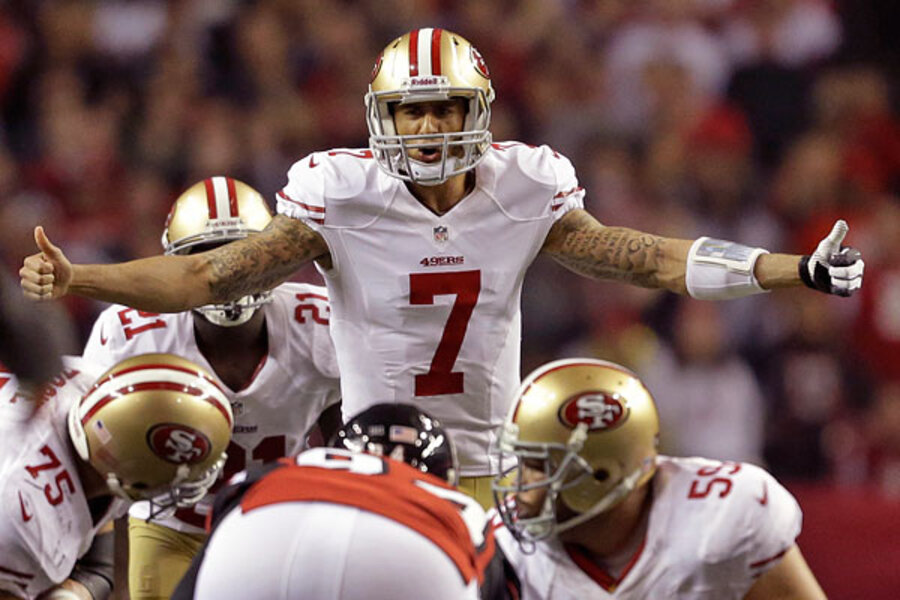Did Jim Harbaugh know Colin Kaepernick was this good?
Loading...
Perhaps this is what Jim Harbaugh imagined. Perhaps, when the San Francisco 49ers traded up to take Colin Kaepernick in the second round of the 2011 draft, Harbaugh knew that the rangy quarterback with a bodybuilder's arms and a sprinter's legs could stand in a cauldron of sound, down 17 points, in his ninth professional game, and lead his team to the Super Bowl.
If so, then his reward is fitting. Forty-niners coach Harbaugh is taking an offense no one knows how to stop – led by a star quarterback that seemingly no one but he saw coming – to the National Football League title game Feb. 3 in New Orleans.
Last week, Kaepernick continued this season's reinvention of the modern quarterback with a record 181 yards rushing against the Green Bay Packers. This Sunday, he did nothing too far beyond the ordinary – which, in its way, was spectacular.
The Atlanta Falcons had seen what Kaepernick did to the Packers, and their defense Sunday was designed to prevent him from doing it to them. That part worked. But in the end, it didn't help them much.
Kaepernick merely showed that he could do it the Peyton Manning way, too – beating a team with his arm from inside the pocket.
For opposing teams, it presents a particularly unappealing choice: Which way do you want him to beat you?
The problem, of course, is that even when Kaepernick isn't doing anything more elaborate than handing off the ball to Frank Gore, the threat of him doing more ties defenses into knots. So Atlanta essentially told its defensive ends, "Don't let Colin go anywhere." And they didn't. But Gore did – largely because those defensive ends were watching him blow by on crucial red-zone touchdowns.
On Sunday, Kaepernick's best decision – again and again – was not to run the ball.
And when he dropped back to pass, he looked as comfortable as Sunday afternoon on a front-porch swing. A running quarterback? Only because he can run – and exquisitely. But there is also his arm.
Yes, that arm. The one that was drafted by the Chicago Cubs in 2009 for its pitching prowess. That tattooed slingshot that gives the impression that, just maybe, football's version of Pedro Martinez has lined up behind center.
Yet down 17-0 at the start of the second quarter, neither his arm nor his legs would have mattered much without his calm. Kaepernick showed it last week, coming back to give his astonishing performance after throwing an interception that the Packers returned for a touchdown on the 49ers first possession.
Another young quarterback, Russell Wilson, showed it, too, last week, rallying his Seattle Seahawks from 20-0 down to take a 28-27 lead on the same Falcons with 31 seconds remaining – though on that day the Falcons managed a last-second field goal to win.
And Indianapolis Colts quarterback rookie Andrew Luck somehow managed to take a team that pundits ranked last in preseason polls to an 11-5 record and a playoff berth.
Kaepernick's win Sunday in the NFC championship game – in only his eighth game as a starter, in only his second year as a pro – is simply the latest, indelible evidence that young quarterbacks are not what they used to be.
First-year starters playing in their ninth game are supposed to crumble when they fall behind in the biggest game of their short career, on the road in a stadium where the crowd is making your helmet an echoing house of horrors. After all, no NFC team – no matter how experienced its quarterback – had ever come back to win a conference championship game when trailing by 17 points.
But there was Kaepernick, amid the din of the Georgia Dome, directing the offense as coolly as if these were preseason drills.
The sports world knows Wally Pip as the man who sat out one game with a headache and never again got his job back – his replacement was New York Yankee-legend-to-be Lou Gehrig. Alex Smith, the former 49er starting quarterback who went down in Week 10 with a concussion, deserves more recognition than that. He was, at the time, the top-rated passer in the league.
Perhaps Harbaugh knew what was in store when Kaepernick came off the bench in that game against the St. Louis Rams. It's just the rest of us who are only now beginning to fully appreciate it.







